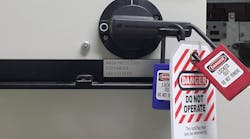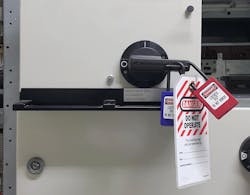It’s that time of year again — when the days start to get a little bit longer and for those of us up north, a little warmer, too. It is also that magical time every three years when we get to celebrate the latest revision of NFPA 70E, Standard for Electrical Safety in the Workplace, hitting the bookshelves and digital marketplaces in its various forms.
The 2018 edition of NFPA 70E seems to be everywhere you turn in the electrical industry as companies dive in and get to work on updating safety programs to the newly revised requirements. The good news is that safety directors need not panic, as there were few changes that substantially shift the concept of safe work practices around electrical equipment. Many of the revisions in this cycle were aimed more at a continued effort made over the course of the last few cycles. For instance, there’s the hierarchy of risk control methods, an increased emphasis on preventive maintenance for personnel safety, and Art. 120, which was entirely rearranged to follow a more logical progression for establishing an electrically safe work condition.
Many of the more significant changes, though, have happened within Art. 130: the idea of risk assessment and the importance of accurately assessing what hazards to employee health exist when performing tasks in the field; old tables are gone, and new tables with increased usability for the NFPA 70E user have surfaced; and material that lived within the Annex is now incorporated within the document. Let’s break these revisions down, and look at the potential impact they will have on how electrical professionals approach electrical safety.
The hierarchy of risk control methods
The concept of a hierarchy of risk control methods is by no means new. It has been a concept within OSHA and was also in an informational note in previous editions of NFPA 70E, which has provided guidance on how employees are protected from hazards in the workplace. However, for the 2018 cycle, a section was added within Art. 110 for the risk assessment procedure to require preventive and protective measures to be implemented in accordance with the following hierarchy:
- Elimination
- Substitution
- Engineering Controls
- Awareness
- Administrative Controls
- Personal Protective Equipment (PPE)
This requirement comes in the form of Sec. 110.3(H)(3). Again, this is not a new concept, but is new to the requirements of NFPA 70E. The addition of this hierarchy mirrors a shift in the attitude toward electrical safety. For years, electrical contractors across the country have been adopting a “No Live Work” policy. As nice as it might be to dream of a world where there is never energized work being performed, the reality is at times there simply is no other option. Imagine trying to troubleshoot a roof top HVAC unit without being able to check voltage and current levels. It would be difficult, if not impossible, to say the least.
So, what does this mean for risk assessment procedures going forward? Simply put, it means that all other possibilities must be exhausted prior to an employee being exposed to a hazard. In other words, dressing up in an arc flash suit is the absolute last resort for protecting employees from arc flash hazards. This should come as refreshing news, since the tests that arc-rated PPE must pass allow for a 50% probability that the clothing will allow enough thermal energy to pass through and cause a second-degree burn.
The purpose of NFPA 70E is to provide a practical safe working area for employees relative to hazards arising from the use of electricity. With this in mind, it helps to simplify the process of risk assessment and follow the hierarchy of risk control methods. The priority is to de-energize equipment. This eliminates the need to expose employees to electrical hazards because the hazard is no longer present. It should be noted, too, that during the process of establishing an electrically safe work condition, one of the steps includes verifying the absence of voltage; the hazard cannot be considered eliminated until after it has been proven that voltage has been removed and operation of the test instrument has been confirmed. This might mean that an employee would need to dress in appropriate PPE to perform this test because until it has been verified that the hazard is gone, it must be assumed that one still exists. However, even this process has seen new and innovative technology emerge and aims at protecting employees from ever having to be exposed to an assumed potential hazard. Permanently mounted absence of voltage testers are emerging to assist employees in verifying the hazard has been removed, without being exposed to a hazard during the verification process.
The Risk Assessment Procedure might also lead what was previously thought to be “justified” energized work to become unjustified during the planning process. For example, as a matter of preparing for the worst and hoping for the best, often it is necessary to develop an alternative plan just in case an unforeseen and catastrophic event occurs. Think about this for a moment: How would we care for patients in the ICU wing of a hospital if energized work were to cause an unexpected shut down of the system? If a back-up plan can be determined for when the system has an unplanned shutdown, it makes sense to implement this plan first and never expose employees to the hazard. This hierarchy now requires that elimination of the hazard to be the priority, and your well-crafted back-up plan just became the first step in ensuring safe work practices.
Re-organization of Art. 120
Previous editions of NFPA 70E had all the right pieces for establishing an electrically safe work condition, but it needed a little tweaking for all the requirements to fall into the right order. The technical changes within Art. 120 are relatively minor in the grand scheme of things, with the exception of permission to use the aforementioned permanently mounted test device for verification of absence of voltage. However, by re-arranging the order in which tasks are listed in Art. 120, the process for establishing an electrically safe work condition is easier to implement.
Previously, the Article started out with the section on verification of an electrically safe work condition. This was leading to some confusion as users of NFPA 70E were jumping around Art. 120 to find the different requirements they needed (as they were following the steps outlined in Sec. 120.1). With the new arrangement, however, Art. 120 is reorganized to increase usability and to provide a more logical flow with the following section layout:
• Section 120.1 (Lockout/Tagout Program)
• Section 120.2 (Lockout/Tagout Principles)
• Section 120.3 (Lockout/Tagout Equipment)
• Section 120.4 (Lockout/Tagout Procedures)
• Section 120.5 (Achieving an Electrically Safe Work Condition)
Now all the requirements for each of these important topics can be found in one place. In addition to reorganizing the requirements that belong in Art. 120, certain requirements were removed and relocated to other sections of NFPA 70E as appropriate. For example, lockout/tagout training and auditing requirements were moved into Art. 110 under the appropriate sections that deal with training and auditing.
The continued evolution of risk assessment
Assessing the amount of risk of injury or damage to health that an employee will face during any given task can be a monumental undertaking; until only a few cycles ago, it was almost impossible. Then something amazing happened. The evolution of risk assessment, in my opinion, is the number one indicator that a fundamental shift in the safety culture of our industry is taking place. Only a few short years ago, certainly at times throughout my career, the attitude toward performing energized work was cavalier at best. I can remember as an apprentice being asked to perform work in switchgear that was energized. I had no PPE, no justification for performing energized work, and certainly no formal risk assessment procedure. The guidance from my journeyman was simply: “Don’t drop your wrench or touch any of the bus bars over here. This stuff is expensive, and takes a long time to get. And, oh yeah, it will hurt, A LOT!”
Fast forward to today, and the procedures in place would never have allowed a conversation like that to take place. However, only with a significant change in the way our industry views safety can we appropriately and accurately assess the risk associated with given tasks and take the necessary steps to minimize our exposure to hazards. The concept of risk assessment has forced employees and employers to be honest with themselves and with each other about what could happen if a wrench is dropped or
accidental contact is made with energized components. The days of such a “macho” attitude of invincibility have given way to more informed discussions about how bad it could be and whether it is worth the risk.
The latest evolution in the risk assessment arena is a major shift in the approach to minimizing the worker’s exposure to hazards. In earlier editions of the standard, the PPE Category method contained a table that specified whether arc flash PPE was required based upon a list of common tasks. However, with the addition of the hierarchy of risk control methods being included in the requirements, now the appropriate method to protect the worker might not be PPE. In fact, PPE must be the last resort for protection. In addition, there was nothing to specify whether additional measures were required to protect workers from equipment that had undergone an incident energy analysis; many users wanted to use a hybrid of the PPE Category “Yes/No” table and the values determined for incident energy — a practice that NFPA 70E specifically prohibited.
This confusion was discussed at length by the committee, and the result is a new Table 130.5(C). This table now applies to either method employed for arc-flash risk assessment. However, it should be noted that this table no longer tells the user whether arc flash PPE is required. Rather, this new table helps in determining if additional measures are needed to protect workers by specifying whether an arc flash is likely to occur for given tasks. This process works in parallel with the hierarchy of risk control methods as well, which is why the table no longer specifies a need for PPE. Per the hierarchy, PPE is only to be used after the other five methods have been exhausted.
One more important distinction about this table is that it does not end the risk assessment procedure. This table is only an estimate of the likelihood of an arc flash occurring, as opposed to the former table, which specified that for some tasks PPE was not required. The risk assessment procedure can still determine there is a need to take additional steps to protect employees, even though Table 130.5(C) lists the likelihood of an arc flash as a “No.”
Let’s look at the example of performing thermal imaging during a maintenance inspection. Per the table, the process of removing the equipment covers does pose an increased likelihood of causing an arc flash; however, once the covers are removed and the thermography is performed outside the restricted approach boundary, the likelihood of occurrence changes to “No.” But does that mean there is no situation where an arc flash could injure the thermographer?
Let’s consider a motor control center (MCC) with automatic control features. If the covers are off and the motor starters are being operated through automatic means, an arc flash hazard might still exist and must be accounted for in the protection of the worker performing the thermography. Unfortunately, there is no “easy” button when it comes to electrical safety, but being armed with knowledge of how the risk assessment procedure is intended to protect workers will go a long way in reducing loss and injury due to electrical incidents.
An increased emphasis on maintenance
The need for proper maintenance of electrical equipment is not a new idea. However, this is one of those areas where the equipment in question is often an “out of sight, out of mind” situation until it fails. There is even equipment where the common course of action is to “set it and forget it.” Equipment failure is the indication that it needs attention, like a light bulb. The maintenance issue continues to surface through risk assessment procedures; however, it is becoming an ever-increasing cog in the personnel safety wheel. If the safety of employees depends on proper operation of certain electrical components, how can it be known whether equipment will operate if there is no record of maintenance?
In the 2015 edition of NFPA 70E the concept of “Normal Operation of Equipment” was added to justified energized work. This included tasks such as operation of SWD/HID circuit breakers to turn on and off lights in a warehouse or jogging a motor starter in an MCC. Normal operation has very specific conditions that must be met for a normal operating condition to exist. The equipment must meet the requirements outlined in Sec. 130.2(A)(4), including the need to be properly installed and maintained. This thrusts maintenance firmly into the forefront when it comes to what is considered “Normal Operation” of equipment.
In addition to the normal operation requirement, the evolution of the risk assessment procedure is also pushing maintenance to the top of the priority list. After all, if all my assumptions and calculations are based on specific operating parameters of given equipment, it is very important that the equipment work as advertised. The only way to be certain that this will happen is to ensure that equipment has been properly maintained and the maintenance documented. Documentation is crucial to track the history and accurately assess what level of risk the future holds.
Honorable mentions
With so many things going on in the evolution of electrical safety, it becomes difficult to spend meaningful time discussing them all in one place. But there are a few additional changes worth noting:
• Two new steps in establishing an Electrically Safe Work Condition.
• Release stored electrical and mechanical energy.
• PPE conformity assessment
• Annex H PPE table incorporated into the requirements.
• Risk assessment must account for human error.
This is by no means meant to be a complete list of all the changes within the 2018 edition of NFPA 70E. By starting a conversation about some of the more important concepts in electrical safety, we can continue to support the shift in attitude of an entire industry segment. At the end of the day, we are all after the same thing. Everyone wants to go home in one piece. Evolving standard work practices take time and buy in from those affected. Only by spreading this message of a revised electrical safety culture can we ever hope to work in a field where nobody gets a ride in an ambulance due to taking an unjustified risk.
Vigstol is the Technical Lead for electrical services at NFPA in Quincy, Mass. He can be reached at [email protected].




